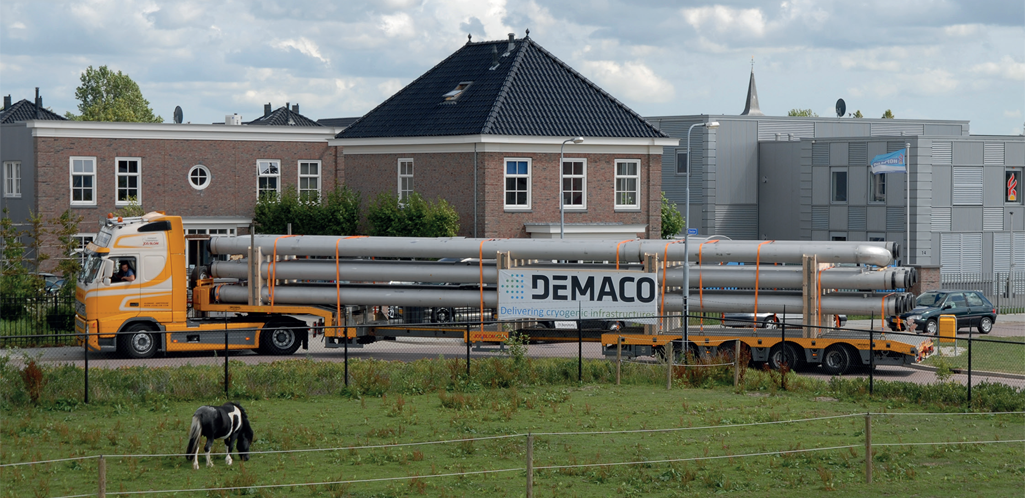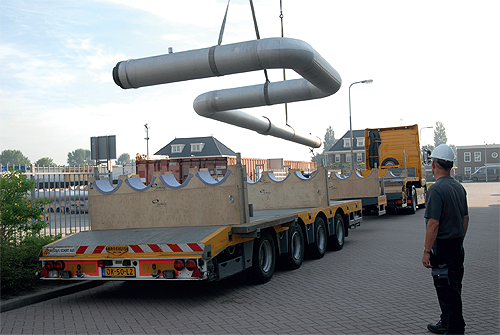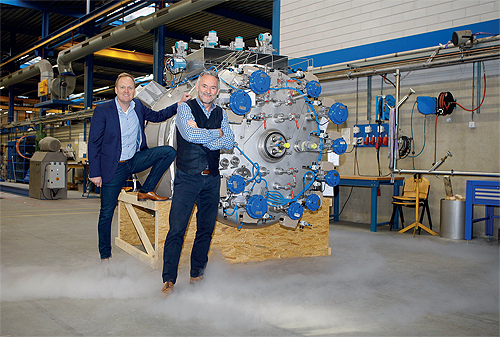
Demaco: Pioneering Cryogenics & Vacuum Technology
Cryogenius
Though Demaco was founded in 1960, it wasn’t until the 1980s that the company really came into cryogenics. Throughout its first 25 years of its existence, the business, established by Theo Dekker, was focused primarily on the manufacture of agricultural and industrial machinery, but that didn’t prevent it from looking for ways to diversify. In 1985, Demaco’s search for a new specialism was successful, and it arrived in the form of cryogenics.
After producing its first vacuum insulated pipeline in 1985, Demaco introduced a dedicated vacuum technology department before the end of the decade. The move established cryogenics as a central pillar of the business. Today, it is Demaco’s sole focus – the company is a prominent cryogenics and vacuum technology specialist on a national and international scale.
“Twelve years after surviving the 2009 financial crisis, Demaco is now a very stable company in the field of cryogenics,” reports company CCO Niels Beers. “What we do is design, manufacture and install vacuum insulated lines – or as we call it, cryogenic infrastructures – for the transport of liquid oxygen nitrogen, argon, LNG, helium and hydrogen. Among a host of benefits these lines have, is their small footprint, superior insulation and short installation times.”
Headquartered in Noord-Scharwoude, 60 kilometers outside Amsterdam, Demaco operates several agencies and brands across the globe, including in France, Spain, Russia, China and Malaysia. A totally integrated organization, Demaco self-performs all pre-design, engineering, manufacturing and testing, making it a one-stop-shop for cryogenic solutions.
Typical projects
Currently owned by Ronald Dekker, son of Founder Theo, Demaco’s core business units cover vacuum components, piping and systems, ASU & LNG infrastructure, helium and hydrogen systems. Thanks to decades of expertise in these areas, the company is able to serve a wide variety of markets, delivering solutions across a huge range of applications. As part of a conversation with Energy, Oil & Gas, Niels describes some of Demaco’s typical projects in more detail.
“In the medical sector, a hospital might have a tank outside the building into which it receives liquid nitrogen from a truck,” he says. “Demaco provides the infrastructure for the next stage of the process – taking the liquid nitrogen from the tank to the cryogenic application in the hospital, at the right pressure and in the right condition.
“We do similar cryogenic infrastructure work in the research sector with liquid helium and liquid hydrogen,” Niels continues. “Helium, in particular, is a very rare gas, so when we supply  infrastructure for liquid helium we make a closed loop system. The liquid helium goes into a tank, from the tank into our produced valve box, then into the helium transfer line for transport to something like the CERN accelerator in Geneva. That’s an example of our high-end market work.”
infrastructure for liquid helium we make a closed loop system. The liquid helium goes into a tank, from the tank into our produced valve box, then into the helium transfer line for transport to something like the CERN accelerator in Geneva. That’s an example of our high-end market work.”
Areas of accomplishment in other markets for Demaco include the shrinking of car parts with liquid nitrogen for the automotive sector, tire chip testing, freezing solutions for the food industry, pressurization for the beverage sector, vacuum and cryo technology for the space industry, and various solutions for the electronic, pharmaceutical and shipping sectors. With Demaco experiencing substantial growth over the last five years, Niels narrows down a few key drivers behind the firm’s recent success.
Large contracts
“We are a well-experienced company in cryogenics, so in the industrial gas world in particular, we are very-well known comand have several large contracts ongoing with gas producers,” Niels explains. “For these companies, we make the cryogenic infrastructure between the liquefier and the storage tank, and between the storage tank and the tank station, for trucks, for a pipeline or for a ship. We deliver the piping, but also the equipment to condition the liquid gas so that it stays liquid from A to B.
“We’ve performed some nice projects in the Nordic region, and recently, we have been carrying out a lot of helium and hydrogen work. A couple of these major contracts have acted as a real boost for us over the last five years and they are a big reason behind why we were able to grow the company and our turnover.”
As Niels says, Demaco is a company with a vast number of projects to its name. A small handful of these developments can be used to showcase the modern leg of the company’s long and storied journey.
Proven pedigree
In 2013, Demaco carried out the first of these contemporary contracts in Lysekil, Sweden, for Cryo AB and the Linde Group, building vacuum insulated transfer lines for the largest LNG receiving terminal in Scandinavia. An important hub for the distribution of LNG as ship fuel, the terminal cost €55 million and benefits from 1.7 kilometers of vacuum insulated pipeline, engineered, produced and delivered by Demaco.
The Lysekil project was succeeded in 2014 by work at the Risavika LNG bunker terminal for Cryonorm BV. Involved in the project from initial concept, through engineering, production and assembly, Demaco oversaw the building and installation of vacuum cominsulated LNG transfer lines for use in the fueling of Fjordline ferries that sail between Norway and Denmark.
Demaco’s third major project in three years arrived in 2015 in the shape of a contract for the design and construction of an LNG plant in the town of Rio Grande, Bolivia. Working for Sener, Demaco played a role in the engineering, manufacturing and installation of vacuum insulated pipelines, as well as measurement control systems at the site. The first of its kind in Bolivia, the Rio Grande LNG plant now distributes natural gas to over 140,000 homes across the country.
In 2017, Demaco took its LNG capabilities to the shipping industry and completed work for Royal IHC on Minerva and Scheldt River, two of the world’s first dredging vessels equipped with dual fuel engines and capable of operating in LNG mode. Part of the DEME fleet, Minerva has ‘Green Passport’ and ‘Clean Design’ notation, meaning it complies and exceeds the strictest international emission requirements. Similarly, Scheldt River is also part of DEME’s multi-year fleet investment program, focused on further increasing efficiency, both in terms of productivity and environmental performance. Demaco designed, engineered, produced and installed LNG bunkering pipelines onboard both vessels.
productivity and environmental performance. Demaco designed, engineered, produced and installed LNG bunkering pipelines onboard both vessels.
Having proven its pedigree across multiple decades, Demaco is now ready for the next challenge. As we move deeper into the New Year, the company’s plans for 2021 are becoming increasingly clear. Two of Demaco’s main aims across the next nine months will be to increase its involvement in both the hydrogen and LNG markets.
“We’ve already done some really good projects in the LNG world, but the sector still remains a bit conservative,” Niels states. “We are delivering cryogenic infrastructure, which means we are delivering double walled pipe systems, but many LNG firms are not used to that. There have been a couple of instances where we’ve had discussions with EPC contractors to convince them of our product. In the short-term, conventional systems seem cheaper, but, in the long-term, our product is much more economic than conventional alternatives.”
Future plans
Hydrogen, which Niels terms ‘the energy carrier of the future’, will also be under the microscope this year at Demaco. The company has already created a basic hydrogen development department, and as a specialist with over 25 years of experience in the transportation of liquid hydrogen, Demaco is studying the ways in which it can best fit into a large, competitive sector.
“There are several exciting new markets for hydrogen,” Niels remarks. “You have hydrogen on ships, forklifts and all sorts of vehicles and applications. With forklifts for example, people have realized that you can refuel them with hydrogen in just ten minutes and then they can drive all day. That is just one of its interesting uses. Wherever our focus ends up, we are very good at producing cryogenic infrastructures and liquid hydrogen is something that we are very capable of transporting from A to B.”
After using 2020 as an opportunity to research the hydrogen market and the opportunities available therein, Demaco is now well positioned to become a key player in the renewable energy world for years to come.
“Hydrogen may be part of oil and gas, but it is better than oil, especially for shipping,” comNiels asserts. “If we look five years ahead, we want to be one of the top performers in the hydrogen market, adding to our existing credentials as a leader in the industrial gas sector – that’s one of our biggest aspirations.”
Demaco Holland B.V.
www.demaco-cryogenics.com
Services: Cryogenic solutions, including vacuum insulated pipes